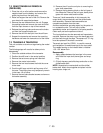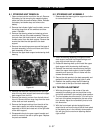
11 - 42
Voltage Measurement
A voltmeter measures the voltage difference between
the test leads and the voltmeter is always connected
across the circuit under test.
Current Measurement
The rules to remember when measuring current with
an ammeter are; an ammeter measures the current
that flows through the meter, and to measure current
an ammeter must be connected into the circuit.
The latter rule means that the circuit must be opened,
and the ammeter wired into it. Because this procedure
is usually difficult, an ammeter is seldom used for trou-
bleshooting.
Resistance Measurement
An ohmmeter is used to make resistance measure-
ments and to check continuity through wires and elec-
trical components.
The ohmmeter has a self contained battery and
requires no electrical power. Using the ohmmeter on a
circuit that has power applied may result in damage to
the meter.
IMPORTANT:
Disconnect the equipment battery when
making Ohmmeter test or damage to the Ohmmeter
may result.
IMPORTANT:
An ohmmeter reads the resistance of
whatever component is connected between the test
leads. It can be used to check wires, coils, light bulbs,
or any item that conducts current.
11.3 BATTERY
Set-Up:
The battery is dry charged. The dealer or customer
must add electrolyte (sulfuric acid and water).
1. Remove the battery from the unit.
2. Remove all the vent caps from the battery and set
the caps to one side.
3. Take the electrolyte which should be 1.265 specific
gravity at 80
o
F (27
o
C), and fill each cell so that the
electrolyte is level with the bottom of the fill ring.
4. The battery should stand for 1/2 hour. Now check
electrolyte level in each cell again. If necessary
add more electrolyte to bring the level up to the
bottom of the ring.
5. Charge until all cells are gassing freely, and the
specific gravity is constant over three successive
readings taken at 30 minute intervals.
6. Immediately after charging, check level of
electrolyte. If the level is low add distilled water to
bring it up to the required level.
7. Replace the vent caps. It is not necessary to
tighten more than finger tight.
8. Wash off the battery to remove electrolyte which
may have spilled.
Maintenance:
Do an occasional visual inspection. See to it that the
battery remains clean, both the case and the terminals.
This visual inspection should be done once a month.
Check the level of the electrolyte. It may be necessary
to add distilled water. This should be checked before
each usage.
Another important check is the specific gravity. The
specific gravity should be checked with the hydrometer.
The reading on the gauge should be above 1.225. If
the reading is allowed to fall below 1.225 specific
gravity you will have an insufficient charge. If this
happens charge the battery until specific gravity of
1.265 is reached over 3 successive readings. This
check should be done monthly.
The state of charge can be determined approximately
by the cell specific gravity or the rested open circuit
voltage at room temperature and the charging time can
be estimated. For example:
If using an automatic tapering 12 volt charger, choosing
a good quality 5 to 10 amps 15VDC minimum output
charger and charge for 3 to 12 hours according to the
battery state of charge (see table above) or until the
specific gravity in each cell reaches 1.255 - 1.265
specific gravity at 80
o
F (27
o
C).
If using a constant current charger, charge at 1 to 2
amperes for the time given on the table above or until
full specific gravity is reached.
IMPORTANT:
Charging at higher rates will damage the
battery and cause excessive gassing and acid
spewing.
OCV Specific
Gravity
% of
Charge
Charging
Time
12.60 1.265 100% ---
12.40 1.225 75% 3 hours
12.20 1.180 50% 7 hours
12.00 1.130 25% 10 hours
11.80 1.100 0% 12 hours
WARNING:
When charging battery, remove it
from the unit and make certain that you
connect the positive (+) lead of the charger to
the positive (+) terminal and the negative (-)
lead to the negative (-) terminal. Reverse
connections can cause sparks and potential
unsafe conditions.


















